- It’s unlikely conservation organizations can survive if they are unwilling to embrace change: as an endeavor, conservation requires not just longterm planning, but also an ability to move proactively and fluidly to protect species and safeguard ecosystems.
- Environmental and education NGO, the Art of Conservation, is currently embarking on its biggest change since its foundation in 2006: moving away from its base in Rwanda, while leaving a legacy behind.
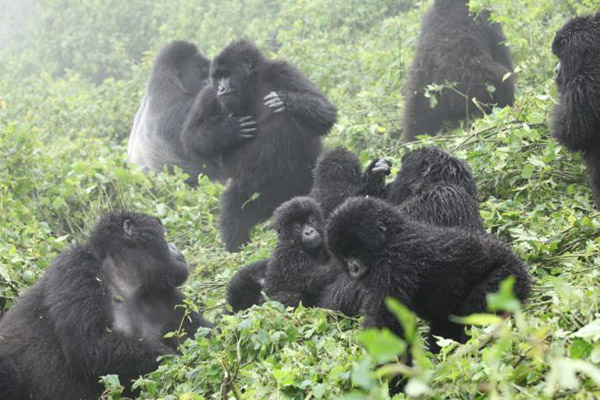
Hirwa Gorilla Group in Volcanoes National Park, Rwanda. Photo © Julie Ghrist.
It’s unlikely conservation organizations can survive if they are unwilling to embrace change: as an endeavor, conservation requires not just longterm planning, but also an ability to move proactively and fluidly to protect species and safeguard ecosystems. Environmental and education NGO, the Art of Conservation, is currently embarking on its biggest change since its foundation in 2006: moving away from its base in Rwanda, while leaving a legacy behind.
“Art of Conservation began as an idea almost a decade ago. It started because like many people I was feeling increasingly demoralized by deforestation, environmental degradation, wild animals squeezed out of their natural habitats with no place to go, the bushmeat trade, and all the other problems affecting the health of our planet,” Julie Ghrist, the head of Art of Conservation told mongabay.com in a recent interview.
An innovative group that combines education, health, and wildlife, Art of Conservation (AoC) spent its seven years in Rwanda, working with local people to understand the intersections between their health and the Critically Endangered mountain gorillas. This year however AoC is officially setting off from Rwanda and beginning the search for a new base of operations. But that doesn’t mean the program will stop in Rwanda. Instead, locals who worked with AoC have started up their own group, Conservation Heritage-Turambe (CHT), which will be completely locally run and managed.
“In my view, this is the best thing that could have happened, because what we started will now have a long-term future,” says Ghrist. “The CHT team will base their lesson plans and community programs on what we developed together, and change them as they go forward. The other exciting thing is that the formation of CHT was a mutually agreed upon next step by the Rwandan AoC team, local officials, the park service, and the schools.”
Since leaving Rwanda, AoC is now on a mission to find a new home to set-up operations and continue their work of aiding wildlife and ecosystems through education, including a recent trip to Guyana. But that doesn’t mean the group is slowing down: an upcoming exhibit at the Pratt Institute in New York City (running from November 8th-January 18th) will highlight AoC’s work in Rwanda, including photos and student artwork. A special event will celebrate the new exhibit on November 22nd.
INTERVIEW WITH JULIE GHRIST
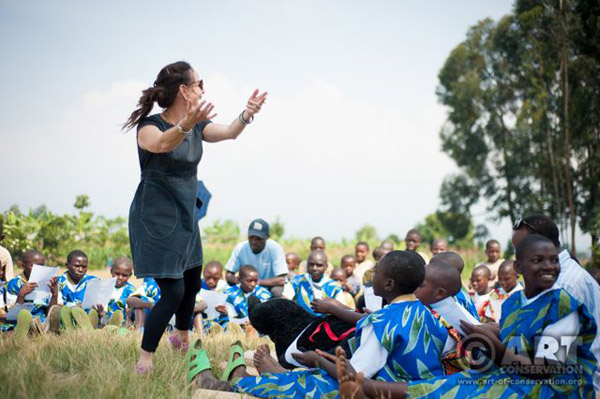
Ghrist (standing) with students (ages around 10 to 15) at Nyange School in Rwanda. Ghrist is choreographing a song called Mu Birunga (In Virunga) by Courtney Kaiser and Benjamin Kartel. The children were readying to perform these song and dances at Igitaramo (community party) the day before Rwanda’s annual gorilla naming ceremony. Photo by: Andrew Walmsley.
Mongabay: Will you tell us about the origins of Art of Conservation?
Julie Ghrist: Art of Conservation began as an idea almost a decade ago. It started because like many people I was feeling increasingly demoralized by deforestation, environmental degradation, wild animals squeezed out of their natural habitats with no place to go, the bushmeat trade, and all the other problems affecting the health of our planet. I could no longer sit still. I wanted to do something, to get involved, to be fully active in righting what I found to be so horribly wrong—or at least try. So, in 2005, I arranged to volunteer with several conservation organizations in Africa. After ending up in Rwanda and working on behalf of mountain gorillas, I realized that what I wanted to do was work with people—especially the kids—whose lives are also affected by the loss of biodiversity.
Mongabay: How does your organization link up saving endangered species with art, education, and health?
Julie Ghrist: ‘Link’ is the appropriate word here! All living things are connected. We cannot help animals unless we are helping people, and people need to be healthy before they can afford to help wildlife. Our approach is to combine learning about biodiversity with raising one-health awareness—in as creative a way as possible. For example, we run after school programs that give students a chance to draw, paint, act, and compose songs and poems about their native wildlife. We run workshops for people of all ages to encourage good basic hygiene, such as handwashing and tooth brushing.
Mongabay: What do you mean by “one-health awareness”?
Julie Ghrist: To have one-health awareness is to understand that human, animal, plant, and environmental health are interconnected. If we damage the environment, for example, then the health of everything in it is affected. To be aware of these connections means being more careful about what we do as individuals that can cause health problems in others, including other people. So it is a big picture, holistic view of health that is inclusive of everyone. To increase one-health awareness, AoC partners with experts in the fields of animal and human health, animal behavior, conservation biology, eco-tourism, engineering, structural design, and more.
For example, in Rwanda, the school children have been told they should to protect the endangered mountain gorilla because gorillas bring in revenue through ecotourism. While this is true, they soon learn from our lessons and activities that gorillas deserve protection for many other reasons. We help the kids explore the entire mountain forest ecosystem, breaking it down into its various elements. Soon they discover they have this extraordinary place right in their backyard!
With our Rwandan students, we used a fun and engaging exercise to help them understand the interconnectedness of life and the role each of them had in protecting the Critically Endangered mountain gorilla. We asked them to create a story with pictures about going to school with each other together. Then we asked them to continue the story by adding in the elders in their lives they view as role models, including people who work in the gorilla park as guides, tour operators, and anti-poaching patrols, as well as their teachers, doctors, and farmers. Next were the animals they take care of in their lives, mostly goats, cows, and dogs. Finally, the story expands to taking care of the community with activities like planting trees which provide oxygen, rainfall, building materials, cooking fuel, and soil erosion prevention.
RWANDA: HEALTH AND GORILLAS
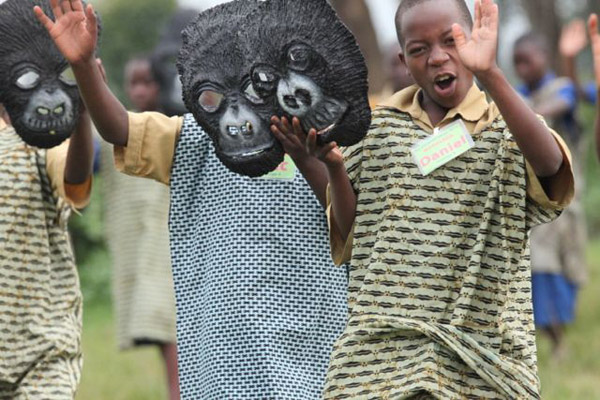
Children preparing for performances. Gorilla animal masks made at AoC studio by AoC teachers Eric Mutabazi and Eusebe Mwizerwa. Photo: © Julie Ghrist.
Mongabay: Your organization started in Rwanda. Why there?
Julie Ghrist: After gaining nearly two years of conservation volunteer experience in countries such as Kenya, Cameroon, Zambia, and Rwanda I decided to remain in Africa and concentrate my efforts there. Having spent a year as a volunteer in the Northern Province of Rwanda, I felt I had a good understanding of the threats facing the Critically Endangered mountain gorilla, as well as the challenges facing the everyday lives of the people living near the Volcanoes National Park. I had also learned more about how human and gorilla health are connected from the veterinarians working for the Mountain Gorilla Veterinary Project (MGVP, Inc.) also known as the Gorilla Doctors. MGVP’s Co-Director, Dr. Mike Cranfield and Regional Veterinary Manager, Dr. Lucy Spelman encouraged me to explore new ways to raise one-health awareness in the community. They agreed to let me start under their well-established organization. That this is when Art of Conservation was officially born—in 2006.
Mongabay: When most foreigners think of Rwanda they think of the 1994 genocide. Should this perception change?
Julie Ghrist: A lot of perceptions about Rwanda and Africa in general should change, but Rwanda’s recent past should not be pushed out of sight or out of mind. The genocide had, and continues to have, a huge impact on the people. It’s also a much more complex situation than many people realize, as the problems involve not just Rwanda, but also Uganda and the Democratic Republic of Congo, the three countries where mountain gorillas live.
Mongabay: Your work primarily focused on the mountain gorillas in Rwanda. Why this species?
Julie Ghrist: We were very lucky that AoC started with such an amazing animal. They are incredible in their own right, and even more amazing when you think about our shared ancestry with them, and the origins of Homo sapiens. One-health awareness is critical for the mountain gorillas because of their small population size, and their close relationship to us. There are only about 880 mountain gorillas living in a relatively small protected area, and most are visited daily by tourists who have traveled from other parts of the world—with their diseases. The possibility of a major infectious disease wiping out the gorillas in a blink of the eye is very real. Climate change is also affecting their forest. All of this matters because mountain gorillas are Rwanda’s keystone species. The income from tourism has had a huge positive impact on a country with years of civil unrest, genocide, and poverty. This may seem like a lot of baggage for a great ape to have to carry for one country, but it’s worth it. Intensive conservation is needed to save them from extinction. I’m thankful AoC has been able to work alongside dozens of smart and compassionate people working to protect the mountain gorillas, and that we were able to contribute.
Mongabay: Will you tell us about the health links between gorillas and humans?
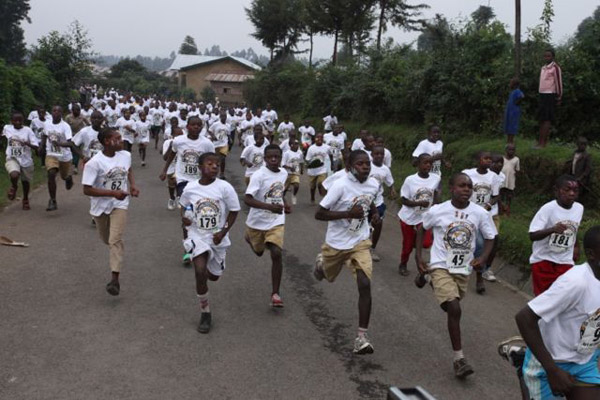
AoC annual event: the 3K Gorilla Fun Run. Ghrist says ‘kids learned sports etiquette, team work, health, and running for gorillas!’ Photo: © Julie Ghrist.
Julie Ghrist: Genetically, gorillas and humans are very similar, which means they suffer from many of the same illnesses as we do. Gorillas get runny noses, diarrhea, and pneumonia, which is the most serious of all. And disease transmission from humans to gorillas is also very possible. The difference is that we are vaccinated for a number of infectious diseases and the gorillas are not.
In our lesson plans, we included “Staying Healthy” messages, and they worked. For example, Jan Ramer, another of the Gorilla Doctors, always laughs when she recounts the story of how she spent time with AoC students. She would ask the kids, “How do you protect mountain gorillas?” The kids would quickly yell, “We stay healthy!” And showing their hands, “We wash our hands!” And with more gestures, “We cover our mouths when we cough and sneeze!” and quickly they would start coughing or sneezing into the inside of their elbow. Those were great answers!
Mongabay: Recently, your local staff started a new organization taking off from Art of Conservation. Will you tell us about Conservation Heritage-Turambe?
Julie Ghrist: The AoC Rwanda team; Valerie, Eric, Innocent, Eusebe, and Olivier asked if they could continue AoC’s work under their own local NGO called Conservation Heritage-Turambe (CHT). In my view, this is the best thing that could have happened, because what we started will now have a long-term future. The CHT team will base their lesson plans and community programs on what we developed together, and change them as they go forward. The other exciting thing is that the formation of CHT was a mutually agreed upon next step by the Rwandan AoC team, local officials, the park service, and the schools. While I will miss AoC in Rwanda, I know they will continue on, and I am thrilled.
Mongabay: Is handing over the reins to dedicated locals the definition of success for any conservation group?
Julie Ghrist: I think it’s different for each conservation group. Some focus more on capacity building, while others focus on providing funding. So it depends on the goal. Every group is different. For AoC, it was definitely a success, and we hope to initiate similar programs in other places.
Mongabay: Will Art of Conservation still be working in Rwanda?
Julie Ghrist: We will, but indirectly, and through administrative support of Conservation Heritage—Turambe. We currently assist CHT with community development projects, as well as some of its operating expenses. We also continue the exchange of ideas and information. But CHT is carrying on with AoC’s work and making it its own. I have great respect and love for the CHT team. We learned so much together over the past 6-7 years. Valerie, Eric, Olivier, Innocent, and Eusebe are a courageous and kind group of individuals. They are proof that anything is possible. I encourage your readers to support CHT—check out our website!
FURTHER AFIELD
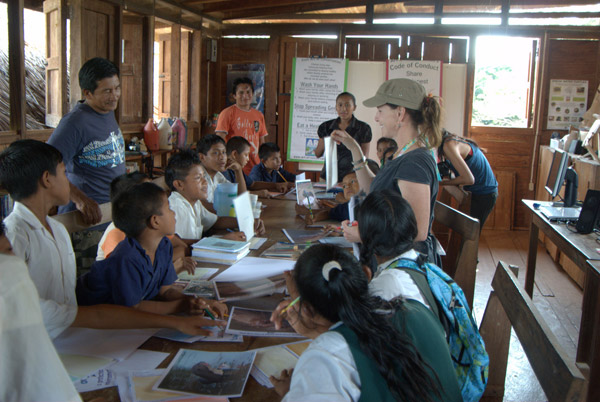
Ghrist at Caiman House at Yupakari Village in Guyana holding a visual and talking to the kids about giant river otters. Photo: © Lucy Spelman.
Mongabay: Will you tell us about your planned expansion?
Julie Ghrist: Sure, it’s exciting and still in the works. We are looking for a new home base, a country in which we believe our programs will be additive to existing conservation efforts, and in which we can become truly immersed, as we did in Rwanda. So we are talking to other groups and doing a bit of traveling. Right now, we are focused on Central America, the Caribbean, and northeastern South America, but that could change.
Mongabay: Will you tell us about your recent trip to Guyana?
Julie Ghrist: In September, we explored the possibility of establishing an AoC program in Guyana, South America. One of our board members, Dr. Lucy Spelman has been working in conservation there for many years, and she took me and AoC Executive Director Allison Hanes to the North Rupununi region to visit the Karanambu Trust and Lodge. We had a great week exploring the wetlands and savanna, and meeting the people. We also visited three village schools, and piloted a new AoC activity in each one. Drawing giant otters was a favorite! This was our first work in a country outside of Rwanda and I felt a bit of pressure! It was great to receive nods of approval from the schools’ head teachers—and smiles from the children.
Mongabay: What species/environments will you focus on in your new location?
Julie Ghrist: We are still exploring our options but we want to focus our efforts on saving endangered species and raising one-health awareness in places where we can make the most difference. At this point, we are leaning toward coral reefs and tropical rainforests. These biological hotspots are home to over half the world’s plant and animal species; they are also vital resources for a wide variety of human cultures. I will let you know as soon as we make the move! In the meantime, I am learning all kinds of new things as I travel and plan.
Mongabay: You’re also planning on visiting Panama soon. What are your group’s plan there?
Julie Ghrist: AoC has been invited to participate in Earth Train’s launch of Biocultural Leadership with Jane Goodall in Panama this November. There will be celebrations for JGI’s Roots & Shoots programs and a dedication of Frank Gehry’s designed Biomuseo. My friend Shea Welsh, the Executive Director of Junglewood—a partner of Earth Train—introduced AoC to this special global community and we are excited to workshop some of our activities with kids and join in the performances. It should be a special time and I’ll share stories and pictures on our blog for you.
CONSERVATION SUCCESS
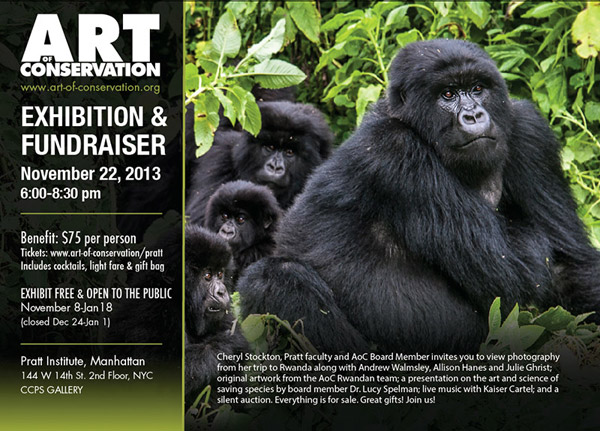 |
Mongabay: Will you tell us about your partnership with Pratt Institute in New York City?
Julie Ghrist: Cheryl ‘Sharp Shooter’ Stockton is my long-time friend, board member, and Pratt faculty member. She has given a great deal of her time and design expertise to AoC over the last 7 years and is now hosting a major event to raise funds for AoC. This past June, Cheryl, Allison, and Andrew Walmsley, a professional wildlife photographer, spent a month with AoC in Rwanda just before the transition to CHT. We had a fantastic time!
Mongabay: What can visitors expect in the upcoming exhibit?
Julie Ghrist: The exhibit includes photography by Cheryl, Andrew, Allison, and myself and artwork created by AoC’s Rwandan staff, and examples of student art work. It includes a major fundraising event on Friday November 22, 2013. Please join us! It’s easy to purchase a $75 ticket through our website. This has to be done soon because tickets won’t be available at the door. The fundraising event includes a presentation by Keynote speaker and board member Dr. Lucy Spelman on Exploring the Art and Science of Saving Species, and music by Kaiser Cartel who has written several songs for AoC.
The exhibit is free and open to the public November 8 through January 18. The location is Pratt Institute, Manhattan. 144 West 14th Street, 2nd Floor in the CCPS Gallery.
We look forward to seeing you there!
Mongabay: What advice would you give small conservation NGOs in order to achieve their goals?
Julie Ghrist: Find partners, and go for it!
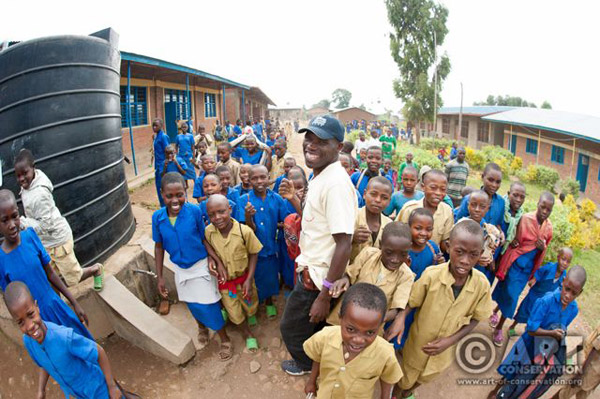
AoC worker, Innocent, at Nyange School with children. AoC gifted Nyange School with three 10,000 liter rain water tanks. Photo: © Andrew Walmsley.
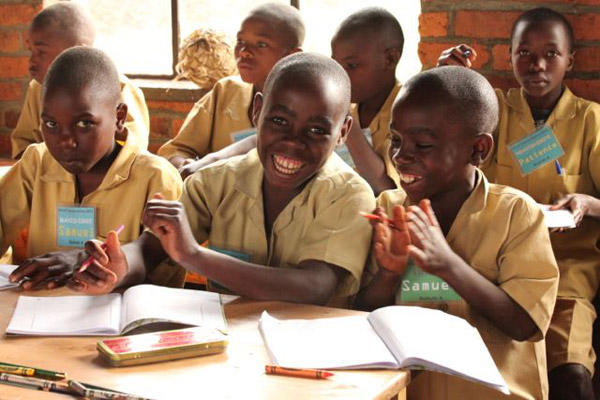
Rwandan children participating in AoC activities. Photo: © Julie Ghrist.
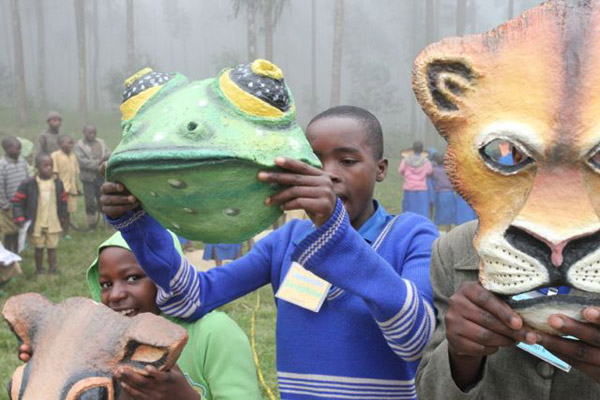
Children practice performing to an AoC song called Heroes of the Forest. Photo: © Julie Ghrist.
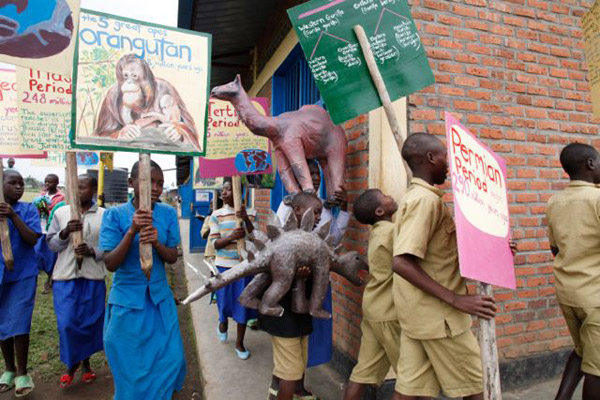
Sign posts for AoC’s Safari Through Time activity: starting with the formation of Earth up to the evolution of the great apes including ourselves. Photo: © Julie Ghrist.
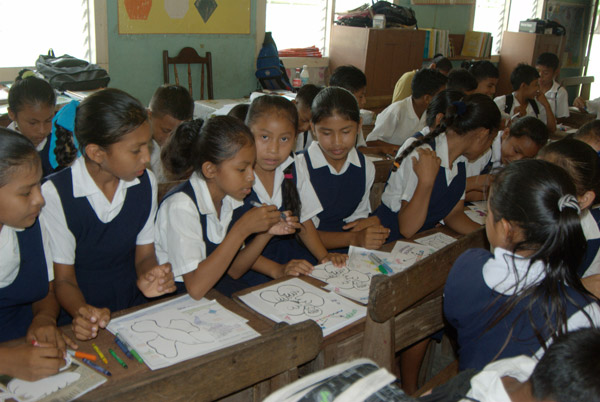
AoC visiting Massara Village in Guyana. Ghrist says ‘they decorated and cut out black and white drawings of butterfly, bird, dog, chicken, gorilla, dog, tree, flower, bee, etc… we connected them all with pipe cleaners to help show how all things are linked together and decorated their classroom with it.’ Photo: © Lucy Spelman.